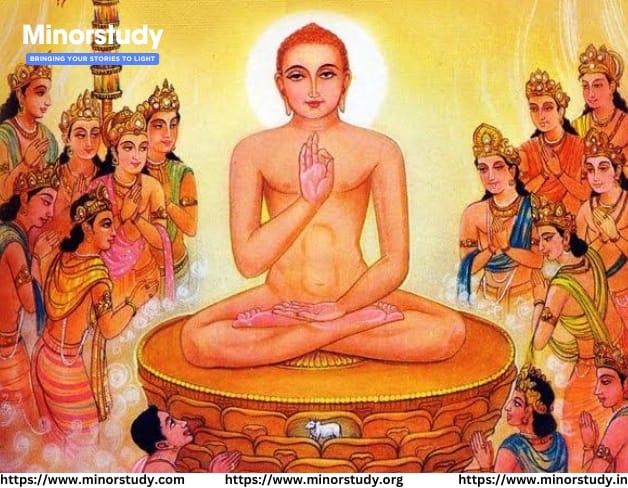🛕 Introduction: Ayodhya – More Than a Name, A Legacy of Unconquerable Faith
“Ayodhya does not exist by name alone, but by the merit of being unconquerable by enemies.”
— Adi Purana by Acharya Jinasena (9th century CE)
- 🛕 Introduction: Ayodhya – More Than a Name, A Legacy of Unconquerable Faith
- 📖 Historical Background: Jainism and Ayodhya – A Deep Connection
- 🧩 Timeline: Jain Events and Significance in Ayodhya
- 🌟 5 Incredible Jain Facts About Ayodhya
- 1. Ayodhya is the Birthplace of Rishabhanatha
- 2. Rishabhanatha Delivered First Ever ‘Dharma Discourse’
- 3. Ayodhya Is a ‘Kalyanak Bhoomi’ for Five Tirthankaras
- 4. Ayodhya Is Older Than Human Civilization in Jain Cosmology
- 5. Tirthankaras’ Lives Celebrated as Part of Jain Festivals
- 🙏 Religious Significance of Ayodhya in Jainism
- 🏛 Jain Temples and Pilgrimage Spots in Ayodhya
- 🕊 Observances and Practices
- 🎯 Importance in Today’s Society and Life
- 💬 Frequently Asked Questions (FAQs)
- Q1. Who was born in Ayodhya according to Jainism?
- Q2. Is Ayodhya only important to Hindus?
- Q3. Is there any Jain literature that mentions Ayodhya?
- Q4. Can non-Jains visit Jain temples in Ayodhya?
- Q5. Why don’t we hear more about Jain Ayodhya?
- 💐 Spiritual Wishing for Ayodhya and Jain Devotees
- 📌 Important Points Recap
- 🧘 Conclusion: Ayodhya’s Eternal Impact on Our Daily Lives
Ayodhya, widely revered in Hindu tradition as the birthplace of Lord Rama, also holds immense spiritual importance in Jainism. It is not just a city, but a divine kshetra, a sacred geography, and a timeless witness to the birth of five Tirthankaras, including Adinatha (Rishabhanatha), the first Tirthankara of Jain Dharma.
For Jains, Ayodhya is not merely historical — it is eternally sacred, woven into the cosmic history of spiritual evolution and moksha. This article dives deep into Jain Ayodhya’s legacy, history, significance, and what it means for us today.
📖 Historical Background: Jainism and Ayodhya – A Deep Connection
Ayodhya, often known by names like Saket, A-yudhya (non-violent), and Ajudhya, finds frequent and respectful mentions in Jain scriptures — especially in Adi Purana written by Acharya Jinasena.
According to Jain beliefs:
Five of the 24 Tirthankaras were born in Ayodhya.
These include Rishabhanatha (Adinath), Ajitanatha, Abhinandanatha, Sumatinatha, and Anantanatha.
Mount Sumeru and Ayodhya are considered the two most sacred cosmic centers of the Jain universe.
Ayodhya is the first city founded by Rishabhanatha — making it the cradle of civilization in Jain tradition.
🧩 Timeline: Jain Events and Significance in Ayodhya
| Period | Event |
|---|---|
| Prehistoric Era | Rishabhanatha is born in Ayodhya as the first Tirthankara. |
| Multiple Eras | Ajitanatha (2nd), Abhinandanatha (4th), Sumatinatha (5th), Anantanatha (14th) born here. |
| 9th Century CE | Adi Purana (by Jinasena) extols Ayodhya’s virtues. |
| Modern Era | Jain temples and shrines developed to honor the Tirthankaras. |
| Today | Pilgrims flock to Kalyanak Bhoomi (birthplace) sites in Ayodhya. |
🌟 5 Incredible Jain Facts About Ayodhya
1. Ayodhya is the Birthplace of Rishabhanatha
Known as the first Tirthankara and father of Indian civilization, Rishabhanatha was born in Ayodhya to King Nabhiraja and Queen Marudevi. He introduced agriculture, art, and architecture.
2. Rishabhanatha Delivered First Ever ‘Dharma Discourse’
He is considered the originator of social living, giving rise to professions like farming, pottery, carpentry, and more — all first taught in Ayodhya.
3. Ayodhya Is a ‘Kalyanak Bhoomi’ for Five Tirthankaras
Kalyanak means an auspicious event — birth, enlightenment, or moksha. Ayodhya is unique as it hosted five Tirthankar births — a cosmic rarity in Jain cosmology.
4. Ayodhya Is Older Than Human Civilization in Jain Cosmology
In Jain time theory, Ayodhya is said to exist for billions of years, recreated and preserved across time cycles.
5. Tirthankaras’ Lives Celebrated as Part of Jain Festivals
Each Tirthankara’s birth is celebrated with rituals, processions, and spiritual discourses across Jain temples, particularly in Ayodhya.
🙏 Religious Significance of Ayodhya in Jainism
For Jain devotees, Ayodhya is not just a place but a spiritual energy center. Here’s why it matters:
Five-fold sanctity due to five Kalyanaks.
Cosmic city that appears in every time cycle.
Site of renunciation, compassion, and divine birth.
Sacred rivers like Sarayu also mentioned in Jain texts.
This holy site is also deeply connected to the concepts of Ahimsa (non-violence), Tapa (penance), and Satya (truth) — core Jain values.
🏛 Jain Temples and Pilgrimage Spots in Ayodhya
While not as vast as the Hindu temples, Ayodhya boasts important Jain pilgrimage locations:
Badi Murti (Big Idol) Temple
Houses beautiful idol of Adinath Ji in standing (Kayotsarga) posture.
Kalyanak Bhoomi Temples
These are specific sites believed to be the exact birthplaces of the Tirthankaras.
Digambara Jain Mandir, Ramkot
Historic and vibrant temple located in central Ayodhya.
Swetambar Jain Temples
Located in nearby areas, celebrating same events with different traditions.
🕊 Observances and Practices
Jain communities observe birthdays (Janma Kalyanaks) of the five Ayodhya Tirthankaras with:
Fasting and Pratikraman (repentance rituals)
Kalpa Sutra readings
Jin-puja and Abhishek rituals
Shobha yatras (holy processions) especially during Paryushan and Mahavir Jayanti
Pilgrims visit Ayodhya to cleanse their karmas, offer donations, and seek inner peace.
🎯 Importance in Today’s Society and Life
In a world of distractions and conflict, Ayodhya’s Jain history offers timeless teachings for personal growth:
| Value | Application |
|---|---|
| Non-violence (Ahimsa) | Reduces aggression in personal, social, and political life. |
| Minimalism (Aparigraha) | Promotes sustainable living. |
| Truthfulness (Satya) | Fosters honesty in relationships and governance. |
| Meditation and Mindfulness | Boosts mental well-being. |
| Respect for all life forms | Encourages environmental ethics. |
Ayodhya teaches us to live in harmony with nature, others, and the self — a message more relevant now than ever.
💬 Frequently Asked Questions (FAQs)
Q1. Who was born in Ayodhya according to Jainism?
Five Tirthankaras — Rishabhanatha, Ajitanatha, Abhinandanatha, Sumatinatha, and Anantanatha.
Q2. Is Ayodhya only important to Hindus?
No. It is equally sacred in Jainism, and has been for thousands of years.
Q3. Is there any Jain literature that mentions Ayodhya?
Yes. The Adi Purana by Acharya Jinasena explicitly praises Ayodhya as a divine and unconquerable city.
Q4. Can non-Jains visit Jain temples in Ayodhya?
Yes, with respectful conduct, all are welcome to learn and explore Jain spirituality.
Q5. Why don’t we hear more about Jain Ayodhya?
Because mainstream narratives overlook minority religions, but efforts are ongoing to revive and document Jain heritage sites.
💐 Spiritual Wishing for Ayodhya and Jain Devotees
“May the light of Tirthankaras born in Ayodhya awaken your soul, calm your mind, and inspire your path to moksha. Jai Jinendra!”
Another devotional greeting:
“On this sacred land of Ayodhya, may we all remember the timeless message of non-violence, truth, and inner peace that Jainism offers through its Tirthankaras.”
📌 Important Points Recap
Ayodhya is the birthplace of five Jain Tirthankaras.
It is a Kalyanak Bhoomi — one of the holiest places in Jainism.
Mentioned with reverence in Adi Purana and Jain Agamas.
Hosts sacred temples and pilgrimage centers.
Symbol of ahimsa, knowledge, and spiritual evolution.
Needs greater recognition in interfaith and national contexts.
🧘 Conclusion: Ayodhya’s Eternal Impact on Our Daily Lives
Ayodhya teaches that divinity lies not in conquest, but in character. The Jain vision of Ayodhya isn’t about power or politics — it’s about peace, purity, and purpose.
In today’s world, where materialism, violence, and ego often dominate, the five Tirthankaras of Ayodhya remind us that the true kingdom lies within.
Whether you’re a Jain or a seeker of spiritual wisdom, visiting or meditating upon Jain Ayodhya is a step towards greater awareness, ethical living, and inner freedom.
Let us recognize, preserve, and celebrate this unconquerable city of the soul — Ayodhya.








